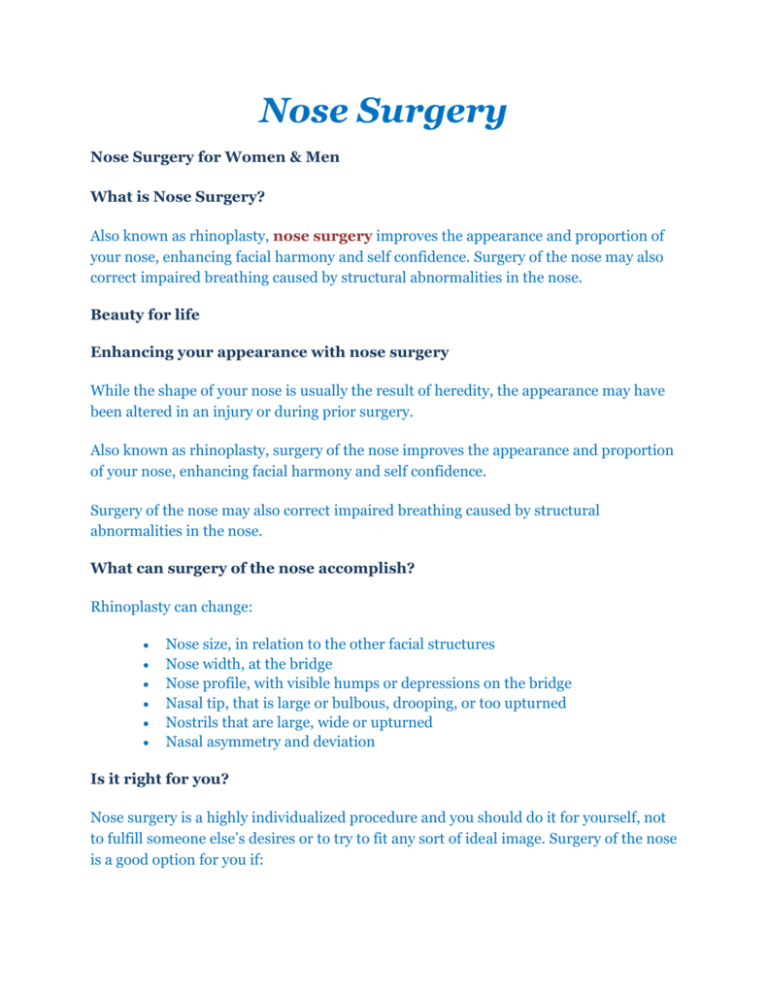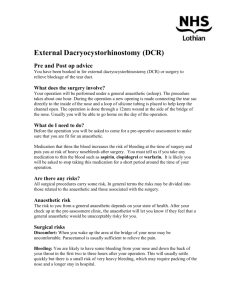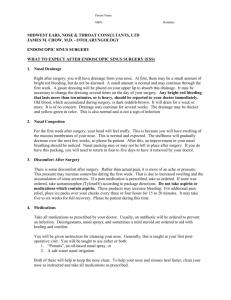Nose Surgery Nose Surgery for Women & Men What is Nose Sur
advertisement

Nose Surgery Nose Surgery for Women & Men What is Nose Surgery? Also known as rhinoplasty, nose surgery improves the appearance and proportion of your nose, enhancing facial harmony and self confidence. Surgery of the nose may also correct impaired breathing caused by structural abnormalities in the nose. Beauty for life Enhancing your appearance with nose surgery While the shape of your nose is usually the result of heredity, the appearance may have been altered in an injury or during prior surgery. Also known as rhinoplasty, surgery of the nose improves the appearance and proportion of your nose, enhancing facial harmony and self confidence. Surgery of the nose may also correct impaired breathing caused by structural abnormalities in the nose. What can surgery of the nose accomplish? Rhinoplasty can change: Nose size, in relation to the other facial structures Nose width, at the bridge Nose profile, with visible humps or depressions on the bridge Nasal tip, that is large or bulbous, drooping, or too upturned Nostrils that are large, wide or upturned Nasal asymmetry and deviation Is it right for you? Nose surgery is a highly individualized procedure and you should do it for yourself, not to fulfill someone else’s desires or to try to fit any sort of ideal image. Surgery of the nose is a good option for you if: Your facial growth is complete and you are 16 years of age or older You are physically healthy You have specific, but realistic goals in mind for the improvement of your appearance What to expect during your consultation The success and safety of your nose surgery depends very much on your complete candidness during your consultation. You’ll be asked a number of questions about your health, desires and lifestyle. Be prepared to discuss: Why you want the surgery, your expectations and desired outcome Medical conditions, drug allergies and previous medical treatments Use of current medications, vitamins, herbal supplements, alcohol, tobacco and drugs Previous surgeries I may also: Evaluate your general health status and any pre-existing health conditions or risk factors Examine and measure your face Take photographs for your medical record Discuss your options and recommend a course of reshaping your nose Discuss likely outcomes of a nose surgery and any risks or potential complications Discuss the type of anesthesia that will be used Preparing for surgery Prior to surgery, you may be asked to: Get lab testing or a medical evaluation Take certain medications or adjust your current medications Avoid taking aspirin, anti-inflammatory drugs and herbal supplements as they can increase bleeding Special instructions you receive will cover: What to do on the night before and the morning of surgery The use of anesthesia during your nose surgery Post-operative care and follow-up We will also discuss where your procedure will be performed. Surgery of the nose may be performed in an ambulatory surgical center or a hospital. You’ll need help If your nose surgery is performed on an outpatient basis, be sure to arrange for someone to drive you to and from surgery and to stay with you for at least the first night following surgery. Procedural Steps Step 1 – Anesthesia Medications are administered for your comfort during the surgical procedure. The choices include intravenous sedation or general anesthesia. We will recommend the best choice for you. “ In 95 % of case, local anesthesia with intravenous sedation is used”. Step 2 – The incision Surgery of the nose is performed either using a closed procedure, where incisions are hidden inside the nose, or an open procedure, where an incision is made across the columella, “ the narrow strip of tissue that separates the nostrils”. Through these incisions, the soft tissues that cover the nose are gently raised, allowing access to reshape the structure of the nose. Step 3 – Reshaping the nose structure Surgery of the nose can reduce or augment nasal structures with the use of cartilage grafted from your own nose or other areas of your body. Most commonly, pieces of cartilage from the septum, “the partition in the middle of the nose, is used for this purpose”. Occasionally a piece of cartilage from the ear and rarely a section of rib cartilage can be used. Step 4 – Correcting a deviated septum If the septum is deviated, it is now straightened and the projections inside the nose are reduced to improve breathing. Step 5 – Closing the incision Once the underlying structure of the nose is sculpted to the desired shape, nasal skin and tissue is redraped and incisions are closed. Additional incisions may be placed in the natural creases of the nostrils to reduce their size. Step 6 – See the results Splints and internal tubes will likely support the nose as it begins to heal , “Tubes for one day, Splints for one week”. While initial swelling subsides within a few weeks, it may take up to 6 months for your new nasal contour to fully refine. During this time you may notice gradual changes in the appearance of your nose as it refines to a more permanent outcome. Swelling may come and go and worsen in the morning during the first weeks following your nose surgery. Nose surgery to improve an obstructed airway requires careful evaluation of the nasal structure as it relates to airflow and breathing. Correction of a deviated septum, one of the most common causes of breathing impairment, is achieved by adjusting the nasal structure to produce better alignment. Important facts about the safety and risks of nose surgery The decision to have nose surgery is extremely personal and you’ll have to decide if the benefits will fulfill your goals and if the risks and potential complications are acceptable. I will explain in detail the risks associated with surgery. The risks include: Rupture of small surface vessels of the nose Infection Poor wound healing Anesthesia risks Bleeding Nose asymmetry Change in skin sensation (numbness) Nasal airway alterations may occur after a rhinoplasty or septoplasty that may interfere with normal passage of air through the nose Nasal septal perforation (a hole in the nasal septum) may develop but is rare; additional surgical treatment may be necessary to repair the nasal septum but in some cases, it may be impossible to correct this complication Skin contour irregularities Skin discoloration and swelling Possibility of revisional surgery When you go home If you experience shortness of breath, chest pains, or unusual heart beats, seek medical attention immediately. Should any of these complications occur, you may require hospitalization and additional treatment. Be careful Following instructions is key to the success of your surgery. It is important that the surgical incisions are not subjected to excessive force, abrasion, or motion during the time of healing. I will give you specific instructions on how to care for yourself. Your recovery After your procedure is completed, a splint, internal tubes or packing will likely be placed inside your nose and a splint placed on the outside to support and protect the new structures during initial healing. A special note: You must practice diligent sun protection until the healing process is fully complete ( 2 to 3 m0nths ). The results will be long-lasting It may take several months for swelling to fully dissipate and up to a year for the outcome of the surgery to fully refine. Although the results of nose surgery are usually permanent, cartilage may continue to reshape and move tissue that may change the outcome over time. How much will nose surgery cost? Cost is always a consideration in elective surgery. Prices for nose surgeries can vary widely. We offer patient financing plans,” with no interest” so be sure to ask. Cost may include: Surgeon’s fee Hospital or surgical facility costs Anesthesia fees Prescriptions for medication Medical tests When nose surgery is performed to improve breathing function, this procedure is considered reconstructive and may be covered by insurance. This requires a detailed examination to verify the cause of your breathing impairment and prior authorization from your insurer. Your satisfaction involves more than a fee When choosing us for rhinoplasty, remember that your comfort is just as important as the final cost of the surgery. Words to know Cartilage: Connective tissue that forms the structure of the nose. Columella: The narrow strip of tissue that separates the nostrils. Deviated septum: Cartilage that separates the nostrils is misaligned which may cause partial nasal airway obstruction. General anesthesia: Drugs and/or gases used during an operation to relieve pain and alter consciousness. Hematoma: Blood pooling beneath the skin. Intravenous sedation: Sedatives administered by injection into a vein to help you relax. Local anesthesia: A drug injected directly to the site of an incision during an operation to relieve pain. Rhinoplasty: Surgery to reshape the nose.








